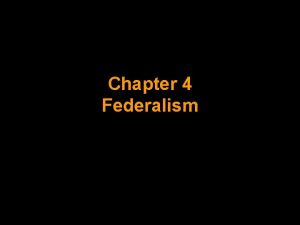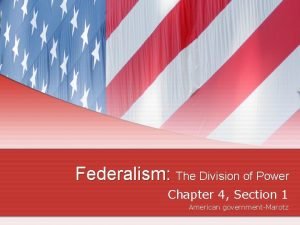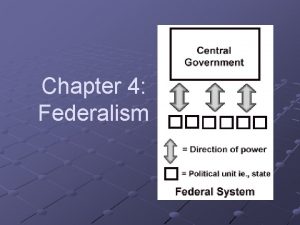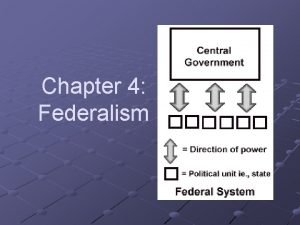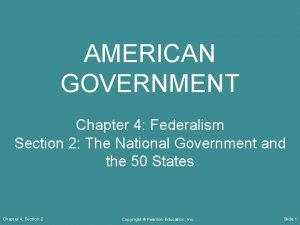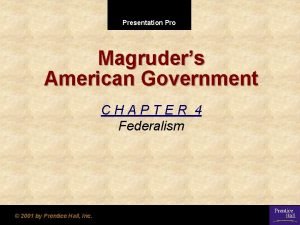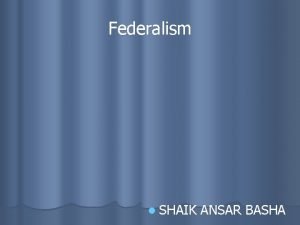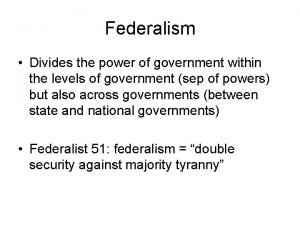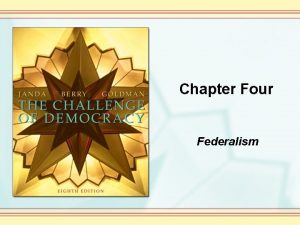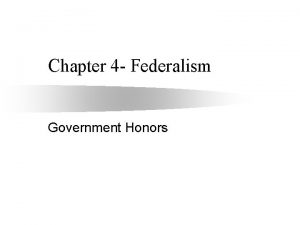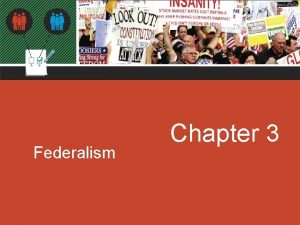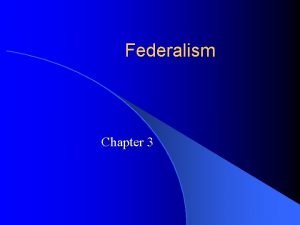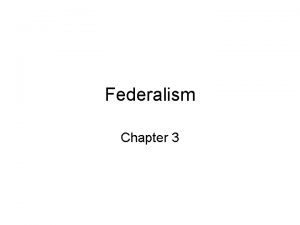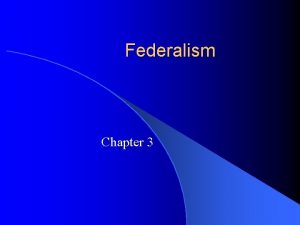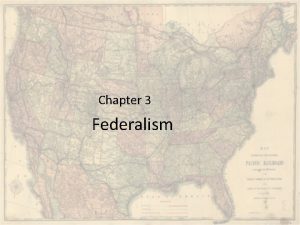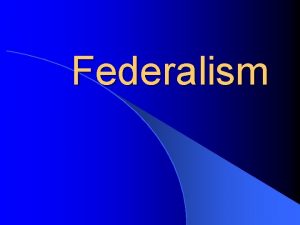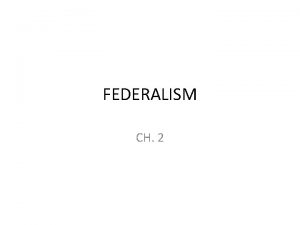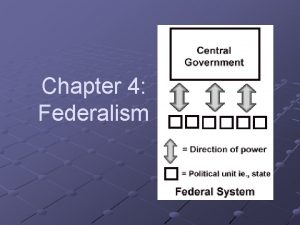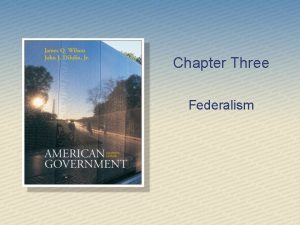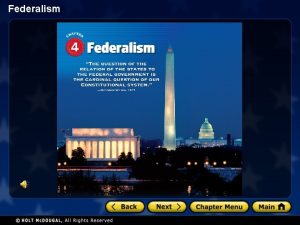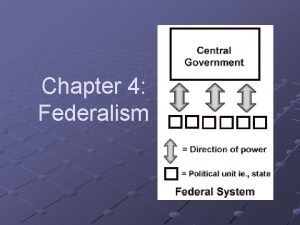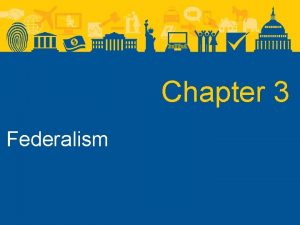Federalism Chapter 3 Defining Federalism l What is





















- Slides: 21

Federalism Chapter 3

Defining Federalism l What is Federalism? – Definition: A way of organizing a nation so that two or more levels of government have formal authority over the land people. l Intergovernmental Relations- – Definition: The workings of the federal system- the entire set of interactions among national, state and local governments.

Defining Federalism

Defining Federalism l Why is Federalism So Important? – Decentralizes our politics l More opportunities to participate – Decentralizes our policies Which government should take care of which problem? l States can solve the same problem in different ways. l

The Constitutional Basis of Federalism l The Division of Power – Supremacy Clause – The U. S. Constitution – Laws of Congress – Treaties – State Constitutions – State Laws

The Constitutional Basis of Federalism

The Constitutional Basis of Federalism l Establishing National Supremacy – Implied Powers – Commerce Powers – The Civil War – The Struggle for Racial Equality

The Constitutional Basis of Federalism l States’ Obligations to Each Other – Full Faith and Credit – Extradition – Privileges and Immunities

Intergovernmental Relations Today l Dual Federalism – Definition: A system of government in which both the states and the national government remain supreme within their own spheres, each responsible for some policies. – Like a layer cake – Ended in the 1930’s

Intergovernmental Relations Today l Cooperative Federalism – Definition: A system of government in which powers and policy assignments are shared between states and the national government. – Shared costs – Shared administration – States follow federal guidelines

Intergovernmental Relations Today

Intergovernmental Relations Today l Fiscal Federalism – Definition: The pattern of spending, taxing, and providing grants in the federal system; it is the cornerstone of the national government’s relations with state and local governments. Figure 3. 2

Intergovernmental Relations Today l Federal Grants to State and Local Governments (Figure 3. 1)

Intergovernmental Relations Today l Fiscal Federalism continued: – The Grant System: Distributing the Federal Pie l Categorical Grants: Federal grants that can be used for specific purposes. They have strings attached. – Project Grants- based on merit – Formula Grants: amount varies based on formulas Block Grants: Federal grants given more or less automatically to support broad programs. l Grants are given to states & local governments l

Intergovernmental Relations Today l Fiscal Federalism continued… – The Scramble for Federal Dollars $350 billion in grants every year l Universalism- a little something for everybody l – The Mandate Blues Mandates are the “strings” attached to federal money l Unfunded mandates are requirements on state & local governments- but no money l

Understanding Federalism l Advantages for Democracy l Disadvantages for Democracy – Increasing access to – States have different government – Local problems can be solved locally – Hard for political parties / interest groups to dominate ALL politics levels of service – Local interest can counteract national interests – Too many levels of government- too much money

Understanding Federalism l State Welfare Benefits (Figure 3. 3)

Understanding Federalism l Spending on Public Education (Figure 3. 4)

Understanding Federalism

Understanding Federalism l Federalism and the Scope of Government – Which level of government is best able to solve the problem? – Which level of government is best able to fund solutions to the problem?

Understanding Federalism l The Public Sector and the Federal System (Figure 3. 5)
 Non-defining relative clauses
Non-defining relative clauses Relative clauses defining and non defining
Relative clauses defining and non defining Non defining
Non defining Defining relative clause meaning in telugu
Defining relative clause meaning in telugu Rel clause
Rel clause Nonessential relative clause
Nonessential relative clause Federalism powers divided worksheet
Federalism powers divided worksheet Chapter 4 section 1 federalism the division of power
Chapter 4 section 1 federalism the division of power Chapter 4 federalism the division of power
Chapter 4 federalism the division of power Chapter 4 federalism
Chapter 4 federalism Chapter 4 federalism
Chapter 4 federalism Chapter 4 federalism answer key
Chapter 4 federalism answer key Full faith and credit clause
Full faith and credit clause Two types of federalism
Two types of federalism Nationalist position definition
Nationalist position definition Federalists and anti-federalists
Federalists and anti-federalists Difference between regionalism and federalism in a sentence
Difference between regionalism and federalism in a sentence How is federalism practised
How is federalism practised Federalists definition
Federalists definition Types of federalism
Types of federalism Basic premise of federalism
Basic premise of federalism Examples of federalism
Examples of federalism







